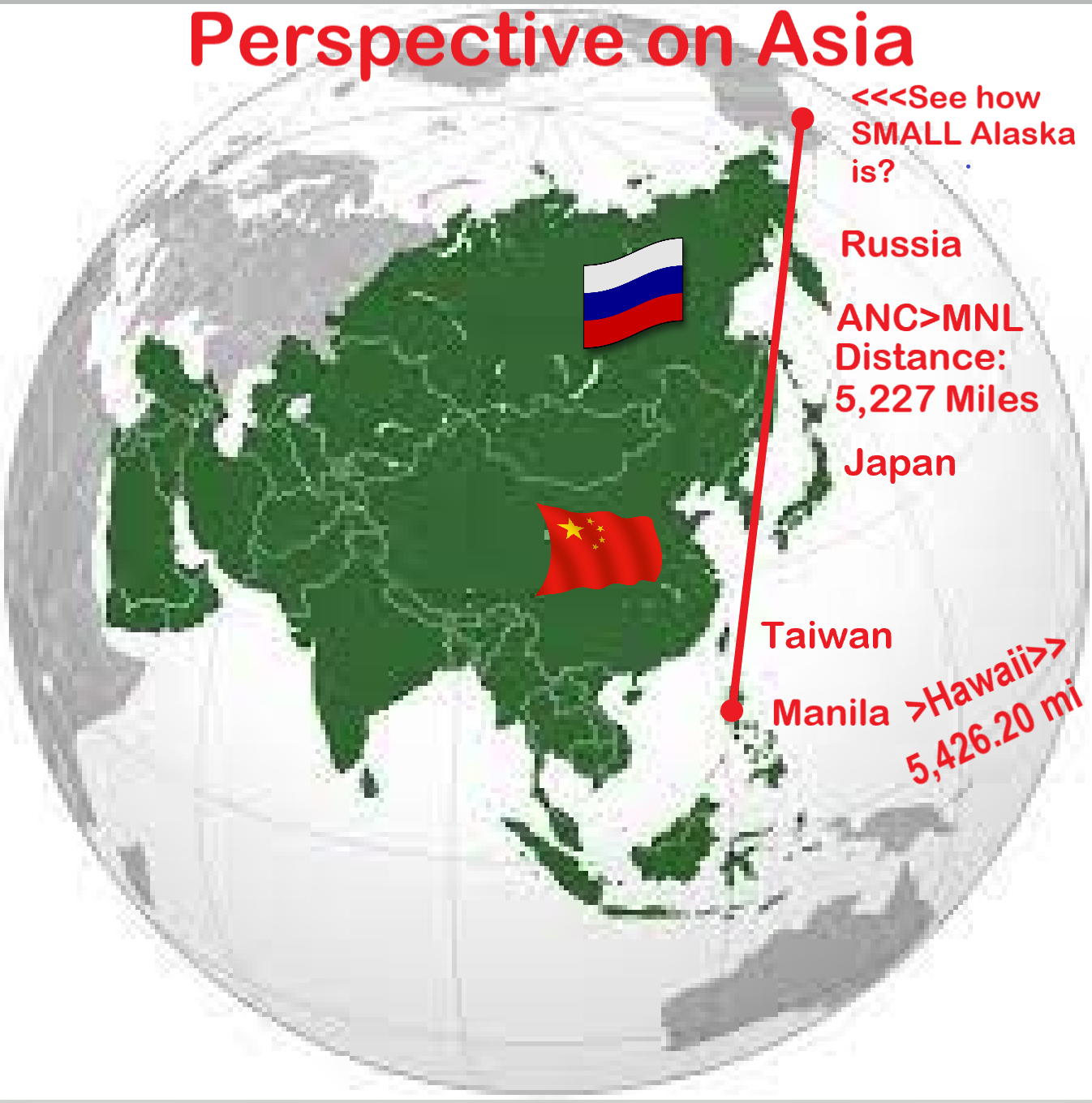Alaska(><)Philippines Connections 8

Over the last six months in Philippines this writer has become interested in the Balance of Power between Asian countries as it relates to the economic interface between USA and China. This interest began with recognizing the enormity of Asia–as the the world’s largest and most ethnically diverse continent–upon which the Philippine Archipelago is just a pimple on its butt. Asia occupies the eastern four-fifths of the giant Eurasian landmass. Asia has both the highest and lowest points on the surface of Earth, the longest coastline of any continent, and is subject overall to the world’s wildest climate extremes.
[1]Asia, Encyclopedia Britannica
The population of Asia is 4,760,834,134 representing 59.76% of the world population. The current population of South-Eastern Asia, which includes Philippines, is 688,331,266 as of Saturday, July 1, 2023, based on the latest United Nations estimates. (Google)
And, while we in the West have fought a civil war for equality of the races during the mid-1800s, diversity is an inadequate word to describe the variety range of people residing throughout Asia. Viewed from a tall location in Manila, people can be seen moving around like the abundant ants that also crowd anyplace food is available here.

Encyclopedia Britannica describes Asia’s influence on the world thus: Asia is the birthplace of all the world’s major religions–Buddhism, Christianity, Hinduism, Islam, and Judaism–and of many minor ones. Of those, only Christianity developed primarily outside of Asia. Christianity exerts little influence on the Asian continent, though many Asian countries have Christian minorities. Of course, Philippines is a Christian dominant country after being part of the Spanish Empire some 333 years, and has enjoyed a special relationship with USA since we bought it for $20 million from Spain as spoils of the Spanish-American war.
[2]Treaty of Paris concluded the Spanish-American War on December 1, 1898.
No outside force will likely ever again take ownership of Philippines, but China’s bully behavior is starting to piss off not only Philippines, but most of it’s Asian neighbors as well. China was once the preeminent power in the world. Chinese leadership takes the long view that it will return to that position of world supremacy again now that it has caught on to how Capitalism works–as the greatest force for good in history–feeding millions of people who previously perished under other economic systems.
Communist China knows Capitalism has been good for Alaska, too.
Asian Political Cauldron
I do not pretend to know everything about the nature of Asian politics, but after reading a couple of books and following some other writers who provide verifiable references for their postings, I am developing some general ideas about things Alaskans might not know about the neighborhood to our west. As part of my investigation into Alaska(><)Philippine Connections I will continue to outline in general terms some of my observations with fact-based sources.

In 2007, the USA’s gross domestic product was almost four times bigger than China’s. Within four years, the USA’s (nominal) GDP was only twice as big, with China poised to become the world’s biggest economy in purchasing power parity terms in late 2014. The resulting trade deficit is pictured below:

Aftermath of WWII
While Washington emerged as the undisputed global hegemon after the utter devastation of European powers and Japan in the Second World War, China’s purported bid for hegemony is anchored by an unprecedented period of prosperity in East Asia and the emergence of Beijing (China) as an indisputable economic partner for the West as well as powerhouse for the developing world.
[3]Asia’s New Battlefield; the USA, China and the struggle for the Western Pacific, p-4
China’s thirst for supremacy and willingness to use unscrupulous practices to get whatever it wants, has made it a sometimes malevolent political force willing to buy politicians if necessary.

[4]Asia Matters for America, May 3, 2017
Mercifully, Gov. Walker was not re-elected and the Liquefied Natural Gas Proposal political football continues to be kicked around by public officials even after previous Gov. Sarah Palin and the Alaska Legislature had GIVEN $500 million to the Trans-Canada Corporation (Now known as TC Energy) for pre-construction studies and other work efforts that never resulted in a single spade of dirt being lifted. Palin quit as governor to run in a chaotic campaign for Vice-President with John McCain against Barack Obama in his re-election bid as USA President.
Some Alaska Politicians are shameless, with Palin even running for the U.S. House of Representatives from Alaska assuring that a liberal Democrat Mary Peltola would win in 2022 under a voting scheme worthy of a 3rd World Country.
[5]Shame of Alaska: Jungle Primary>Ranked Choice Voting

The content below was originally paywalled.
China’s Relationship with the World
China’s economic assent is speculated to be due more to rise of other Asian countries’ economies expanding than the absolute decline of the west.
[6]The Post-American World, Fareed Zakaria
USA has Built Up China at Great Expense to Our Country
One could argue that what the world is witnessing today is a historically unique form of great power rivalry, portending a transition from a unipolar order towards a more complex multipolar system, with China, among a diverse group of emerging powers in the global South, standing as the most promising contender for leadership in Asia. While the USA stands as the only country in human history to have achieved global superpower status, China, in turn, is poised to become the world’s biggest-ever economy, equipped with an unprecedented reservoir of military technological and demographic assets.
[7]The Great Delusion, John Mearsheimer
USA has actively engaged and enabled Communist China. This book was written before the Covid Pandemic and provides a clear overview of how China’s neighbors have been attempting to deal with their neighborhood bully with or without USA assistance.
Far from pursuing a Communist utopia, modern-day China epitomizes the brutal efficiency of state capitalism in the twenty-first century. Decoupled from its revolutionary past, when Beijing served as a leading patron of Communist movements across South-East Asia, today’s China represents a larger, competitive Neo-mercantile state, which is primarily interested in large-scale access to raw materials, advanced (civilian and military) technology, and global consumer markets. Fully integrated into the global chains of production, China stands as the pivot of the global capitalist system: it serves as a leading manufacturing hub, a market for intermediate-capital goods, and a source of affordable financing as well as cheap labor for the industrialized West.
[8]Asia’s New Battlefield; the USA, China and the struggle for the Western Pacific, p-11
Americans realized in the face of an international pandemic that we have outsourced much of our medical supply chain and essential manufacturing. The problems of China stealing intellectual property and producing cheap knock-offs of many USA products have come to light in this event.
As a result, this is how the balance of trade works out for Philippines with USA and China:


After three decades of relentless economic growth, however, China is yet to emerge as a full-spectrum competitor to the USA. While one could argue that China has achieved economic dominance in Asia, emerging as the biggest trading partner of all major economies in the region, the USA continues to be the preeminent naval power in the region, with Japan and Australia acting as key elements of Washington’s ‘hub and spokes’ alliance structure in the Asian-Pacific theatre.
[9] Ibid p-12
New Asian Awareness
The longest serving prime minister in Japanese history, Shinzo Abe in 2007 initiated the Quadrilateral Security Dialogue during his first tenure as prime minister, aimed at resisting China’s rise as a superpower. Known as the QUAD, this networking vehicle was between Australia, India, Japan and USA. The dialogue was paralleled by joint military exercises of an unprecedented scale, titled Exercise Malabar, presumably to get China’s attention.

Australia, India, Japan and USA are members of QUAD. Satellites of USA include states of Hawaii and Alaska but no other Asian country is in the clique.
[10]Quadrilateral Security Dialogue, Wikipedia
Emerging New Powers in Asia
In August 2017, Japan invited Australia, India and the US to hold a joint foreign ministers meeting during the Association of Southeast Asian Nations (ASEAN) summit in November.
In November 2016, American president-elect Trump and Prime Minister Abe met and agreed to pursue what Japan calls a Free and Open Indo-Pacific strategy, originally a concept developed by US Secretary of State Hillary Clinton. The agreement was regarded as a response to China’s Belt and Road Initiative (BRI), and Chinese minister Geng Shuang responded by stating that: such multilateral initiatives should promote cooperation among countries concerned and not be turned into exclusionary frameworks.
The Belt and Road Initiative came at a time when China has difficult relations with states in the Southeast Asian sub-region which includes countries of Philippines, Malaysia, Indonesia, Singapore, Brunei and Vietnam. China now claims some 80% of the South China Sea along with the Paracels and Spratly Islands. All but a couple of Asian countries are tiring of the China bully behavior which is stimulating Japan, India and Australia to become more assertive in their own economic and political interests.
Through the BRI, China is saying it will make huge investments in Southeast Asian infrastructure, including railways, highways, seaports, power plants and digital communication network facilities, but after five years little has materialized from commitments made to previous Philippine President Rodrigo Duterte.
[11]China’s grand Belt and Road Initiative and the Duterte admin, Renato Cruz De Castro, Philippine Star
There was a time when XI may have tried to con Alaska into a deal for our Natural Gas similar to the BRI–now facing a backlash in Southeast Asia–after seeing the caliber of our elected officials. Hopefully that offer to Gov. Walker is off the table until Alaska again becomes financially desperate from elected officials pissing away our resource wealth with unsustainable State budgets.
Taking the long view of Alaska public policy, by then China won’t have to buy a governor anymore.
References:
[1]Asia, Encyclopedia Briticana
https://www.britannica.com/place/Asia
[2]Treaty of Paris concluded the Spanish-American War on December 1, 1898.
https://www.britannica.com/event/Treaty-of-Paris-1898
…on October 1, U.S. President William McKinley had finally decided that the United States must take possession of the Philippines. The demand was ultimately accepted with great reluctance by Spain, with the stipulation that the United States should pay Spain $20 million nominally for public buildings andpublic worksin the Philippines.
The treaty was vigorously opposed in the U.S. Senate as inaugurating a policy of “imperialism” in the Philippines and was approved on Feb. 6, 1899, by only a single vote. Two days earlier, hostilities had begun at Manila between U.S. troops andinsurgentsled byEmilio Aguinaldo. For more than three years the Filipinos carried onguerrilla warfareagainst U.S. rule.
[3Asia’s New Battlefield; the USA, China a nd the struggle for the Western Pacific, by Richard Javid Heydarian, Anvil Publishing, Inc. Mandaluyong City 1550 Philippines, 2017 p-4.
[4]]Asia Matters for America, May 3, 2017
https://asiamattersforamerica.org/articles/chinese-president-xi-jinping-meets-with-alaska-governor-bill-walker
Chinese President Xi Jinping meets with Alaska Governor Bill Walker
BY GENNA LIU MAY 03, 2017
Acknowledging China as Alaska’s largest trading partner, Governor Walker expressed hopes to expand trade ties, especially in the energy sector. He presented the state’s newliquefied natural gas proposal, a project that would expedite thedelivery and exportof natural gas, and for which he is seeking financial backing. The president and governor also discussed opportunities for the Chinese Olympic teams to train in Alaska before the 2022 Winter Olympics in China.
[5]Shame of Alaska: Jungle Primary>Ranked Choice Voting
https://donnliston.co/2023/02/shame-of-alaska/
Richard Javad Jeydarian is an assistant professor in political science and international relations at De La Salle University, the Philippines, and served as a foreign policy advisor at the Philippine House of Representatives from 2009 to 2015. He has also been a consultant for various national and international institutions, advising on economic and foreign policy issues concerning the Philippines and East Asia.
[6]Fareed Zakaria, The Post-American World, 28
[7]The Great Delusion, John Mearsheimer
The Impossible Dream
(pp. 1-13)
https://doi.org/10.2307/j.ctv5cgb1w.4
https://www.jstor.org/stable/j.ctv5cgb1w.4
Liberal hegemony is an ambitious strategy in which a state aims to turn as many countries as possible into liberal democracies like itself while also promoting an open international economy and building international institutions. In essence, the liberal state seeks to spread its own values far and wide. My goal in this book is to describe what happens when a powerful state pursues this strategy at the expense of balance-of-power politics.
[8]Asia’s New Battlefield, p-11
[9]Ibid p-12
[10]Quadrilateral Security Dialogue, Wikipedia
https://en.wikipedia.org/wiki/Quadrilateral_Security_Dialogue
The initiation of an American, Japanese, Australian and Indian defence arrangement, modelled on the concept of aDemocratic Peace, was credited to Japanese Prime Minister Shinzo Abe.[35]The Quadrilateral was supposed to establish an “Asian Arc of Democracy”, envisioned to ultimately include countries in Central Asia, Mongolia, the Korean Peninsula, and other countries in Southeast Asia: “virtually all the countries on China’s periphery, except for China itself.” This led some critics, such as formerU.S. State DepartmentofficialMorton Abramowitz, to call the project “an anti-Chinese move”,[36]while others have called it a “democratic challenge” to the projected Chinese century, mounted by Asian powers in coordination with the United States. While China has traditionally favoured theShanghai Cooperation Organisation, the Quadrilateral was viewed as an “AsianNATO;” Daniel Twining of the German Marshall Fund of the United States has written that the arrangement “could lead to military conflict,” or could instead “lay an enduring foundation for peace” if China becomes a democratic leader in Asia
After Hegemony; Cooperation and Discord in the World Political Economy
https://press.princeton.edu/books/paperback/9780691122489/after-hegemony
[11]China’s grand Belt and Road Initiative and the Duterte admin, Renato Cruz De Castro, Philipine Star
https://www.philstar.com/news-commentary/2021/05/15/2098452/commentary-chinas-grand-belt-and-road-initiative-and-duterte-admin
Renato Cruz de Castro is a trustee and convenor of the National Security and East Asian Affairs Program of think tank Stratbase ADR Institute.
Join to regularly receive my Postcards from Philippines!





